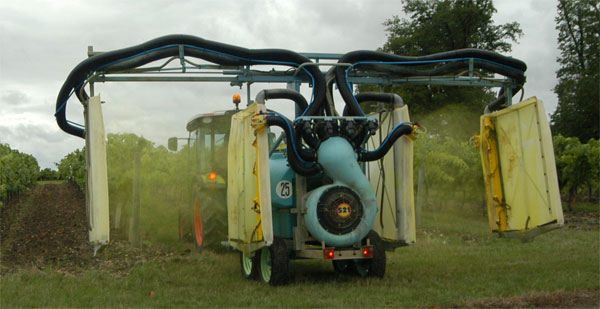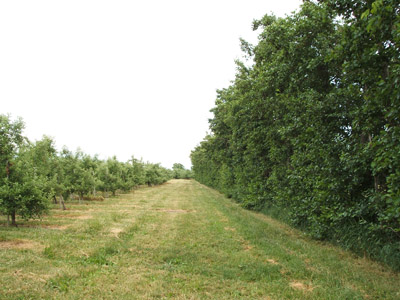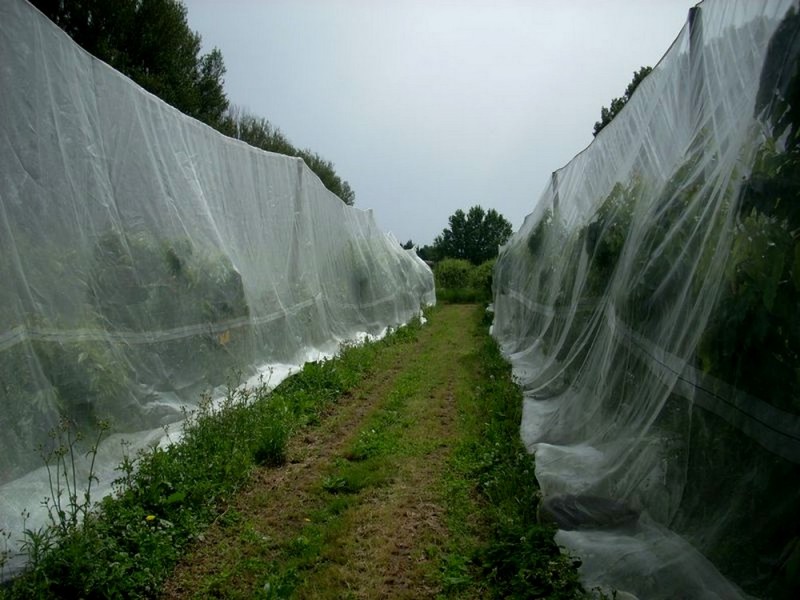AGROECOLOGY
- AIR QUALITY
I recently
had the opportunity to talk to someone who is, as they say,
"knowledgeable" about something that could become quite quickly a
burning issue.
The French
government, within the framework of its political project for the promotion and
development of agroecology (see https://culturagriculture.blogspot.com.es/2016/04/74-agroecology-1-concept.html),
has launched an interesting and extensive study on air quality in rural areas
to measure the invisible impact of farming practices on the air we breathe.
http://france3-regions.francetvinfo.fr/poitou-charentes/sites/regions_france3/files/styles/top_big/public/assets/images/2013/06/25/capteur-air-atmo-picardie-25062013.jpg?
Itok = lLtysJC8
To do this,
specific sensors have been placed in villages (alongside agricultural areas, in
the heart of villages, in school yards, etc.).
For the
study to be complete, sensors have also been placed in large cities, in order
to have the necessary references of areas remote from agricultural influence.
These
numerous sensors measure air quality 24 hours a day, and measurements are
related to agricultural practices of each region, in order to draw the relevant
conclusions.
At
the same time, manufacturers of agricultural machinery are working on possible
developments of specialized equipment in order to minimize the impact on air
quality, in particular of pesticide applications. They study types of nozzles,
ventilation turbines, systems for recovering surplus pesticides, etc.
http://www.matevi-france.com/uploads/pics/pulverisateur-panneaux-recuperateurs-pneumatique-Pulve-S21_01.jpg
At the same
time also, researchers in agronomy of many specialties, are studying the modes
of cultivation able to adapt to different equipment. For example, fruit hedges
make possible to use equipment that free orchards do not allow.
They are
studying the possibility of installing high protective hedges around
agricultural areas to have the effect of a "recuperator" of pesticide
drifts (at the same time as they serve as refuges for the useful fauna, thus
helping to reduce the use of pesticides, and also as protection against
negative effects of wind).
http://www.omafra.gov.on.ca/neworchard/images/apples/16windbreakf1-zoom.jpg
They also
study, in coordination with specialized organisms in organic farming,
alternative means to protect crops (ozonization, low electric waves, and insect
nets, for example).
http://mapassionduverger.fr/wp-content/uploads/2014/09/238-Alt-mouches-pour-cerisiers-Four-lutter-contre-la-mouche-de-la-cerise.jpg
At the same
time again, pesticide manufacturers are working on molecules, additives and
formulations that don't produce vapors to reduce the risk of pesticides being
unintentionally found in the air we breathe, and to maximize the amount of the
molecule able to reach its target, with the least possible collateral damage.
And
at the same time at last, seed growers and creators of new varieties work to
create, through natural ways or with the help of biotechnology, more rustic
varieties, less susceptible to diseases and pests, in order to reduce the need
to have to use pesticides. Unfortunately, they often come up against the misunderstanding
of the public who do not realize that the health and environmental benefits
that these new varieties can bring are far greater than any hypothetic
disadvantages that until now nobody has been able to scientifically demonstrate.
In short,
all specialized public or private organizations involved in this great movement
of agroecology development, are working hard to solve the air pollution caused
by agriculture.
It seems
that many conclusions of this important multidisciplinary research work could
almost be published.
Yet the
results of air quality studies are still not available to the public.
It is
because are emerging some rather embarrassing, politically not very correct
conclusions which, for the coherence of the movement to be total, could lead to
legislations and obligations that nobody really wants.
For example?
Some sensors
are detecting organochlorine, or different types of products prohibited for a
very long time in agriculture. Would farmers have built up huge stocks to be
able to follow (illegally) using them during 40 years after the bans? The
hypothesis is easy to verify. It is also totally silly. But why not, right? But
it no longer holds when sensors of downtown, very distant from fields, even in
big agglomerations, confirm it.
Http://images.midilibre.fr/images/2014/06/24/la-cour-de-l-ecole-maternelle-de-salindres-a-connu-une-belle_956951_667x333.jpg?v=1
Then
it is necessary to envisage something else. A real investigation work is
therefore launched to understand the phenomenon. In fact, this work, the
consequences of which could be immeasurable, is proving that agricultural
pollution, which is real, but probably very largely overestimated and, above
all, largely over-mediatized thanks to the influence and lobbying of organic movements,
is only a small part of the problem of air quality.
One of the
triggers of this study was the famous case of intoxication of children from a
village school beside Bordeaux, as a result of phytosanitary treatments in the
surrounding vineyards. The media coverage of this case was, from the start,
extremely dishonest, accusing conventional agriculture and synthetic
pesticides, when in reality two neighboring farmers were involved, one in
conventional agriculture and the other in organic farming, while both were
spraying their vineyards with sulfur, a natural product authorized in organic
and conventional agriculture.
In fact,
many industrial processes use pesticides, especially those that use raw
materials of animal or plant origin. For example, the treatment of carpentries.
The case I am talking about concerns school facilities whose timber, made of
treated wood (what we call an autoclave, a wood injected under high pressure,
with different pesticides and metal salts to prevent fungi and insects from
attacking it), whose origin is extra-European, release in the air, 24 hours a
day, residues of pesticides prohibited in Europe for a very long time.
However,
these industrial processes applied to products of agricultural origin but of
different use, are not sufficiently controlled, neither in origin nor when they
are imported. No residue analysis is done on timber, fabrics or hides.
However,
these materials fill our homes, offices and public places.
We control
food, it's normal. What we ingest should be safe, we all agree on that.
But this
study, which is clearly focused on agricultural practices, could reveal many
unsuspected problems that could disturb many people.
It
has already been necessary, a short time ago, and it cost a real fortune to
States, to remove asbestos from all buildings. Imagine if it is now necessary
to disassemble one by one all carpentries or to discard millions of furniture
or accessories various and varied.
http://www.zero-amiante.fr/images/entreprise-desamiantage.jpg
Who will pay
these bills?
But public
health has a very high cost, both economically and politically.
When will we
see the publication of these results, in their entirety? And who will risk
taking responsibility for the situation and the measures to be taken?
Politicians
who launched this study, with the obvious idea in mind, in the short to medium
term, of banning many pesticides, could be faced with a much more serious,
difficult and costly problem to solve. A kind of return of the stick, of an
irrational dogmatism.
This is
where we see that agroecology is a deeply good idea. I truly believe that
integrating agriculture into its environment and into society is a real good
idea. To succeed in bringing modern agriculture and today's society together is
a necessity, and this movement of agroecology carries with it the potential to
make it happen.
Yet,
at least in France, the government itself demonstrates that it does not seek to
integrate agriculture into society, but seeks to oblige agriculture to
transform itself into organic agriculture. There is no scientific basis to
support this idea. There is much more ideology than common sense in this
project.
Do you doubt
it? Look at the impressive amount of television programs against agriculture
(so-called "agri-bashing") broadcast in recent years on French public
service channels, thus with the endorsement of the government. All these
programs work on the same model: we take a relatively harmless subject, we
present it in its most negative angle, we fake the images or the way of
filming, we garnish it with some unverifiable but disturbing testimonies, and
we add some comments full of innuendo ... without forgetting the importance of
a horror film music. The shadow of a doubt.
You can read
again "The Alar Case" http://culturagriculture.blogspot.com.es/2015/02/38-alar-scare.html.
Especially
when you know that it is so easy to manipulate minds. Because the reality of
the subjects of all these programs is quite different. Today's food is healthy
and safe. It has even never been so healthy and safe in all the history of
mankind.
http://imgc.allpostersimages.com/images/P-473-488-90/67/6718/ETLA100Z/posters/shadow-of-a-doubt-joseph-cotten-teresa-wright-1943.jpg
But letting
the doubt run will lead the people to make themselves the decision to change
course, even to rush to a gross mistake.
"A lie
repeated ten times remains a lie; repeated a thousand times, it becomes a truth
". (Adolf Hitler).
But
considering all that this work will discover, is it reasonable to continue to
call this movement "agroecology"?







This blog provides an excellent explanation of silt fences and their importance. In agricultural areas, silt fences are crucial for controlling soil erosion during land cultivation. Our high-quality silt fences are ideal for such environments, ensuring effective sediment control. Contact us for professional Silt fence installation to safeguard your land.
RépondreSupprimerThe Polyethylene high density sheet are strong, lightweight plastic sheets made from high-density polyethylene. They offer excellent resistance to impact, moisture, chemicals, and UV rays, making them ideal for industrial, construction, marine, and food-grade applications. Durable, easy to fabricate, and fully recyclable, HDPE Sheets are a versatile and eco-friendly material choice.
RépondreSupprimerThe Pipeline Weight Bags are specially designed geotextile or polypropylene bags filled with materials like sand or gravel to provide stable and secure weighting for pipelines. These bags help prevent pipeline flotation in waterlogged or submerged conditions. Durable, flexible, and easy to install, they are commonly used in oil, gas, and water pipeline projects to ensure long-term stability without damaging the pipeline coating.
RépondreSupprimer